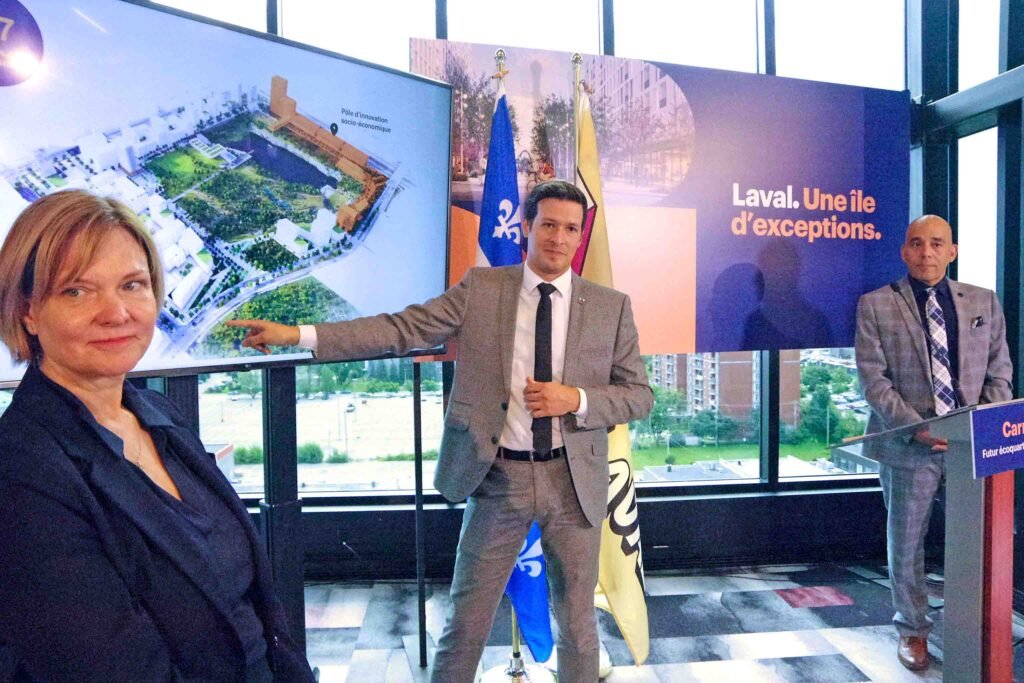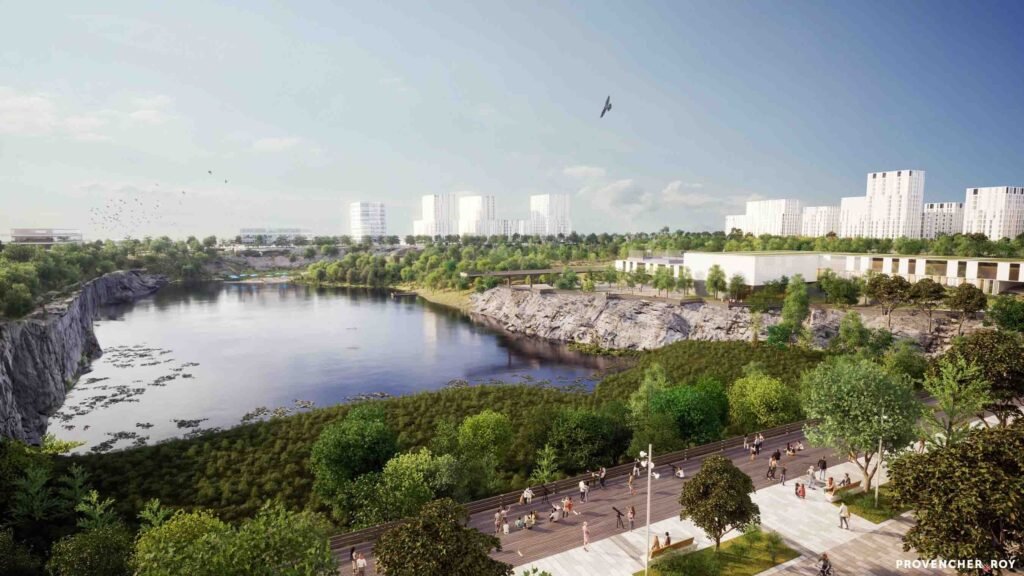New downtown sector would include up to 3,500 housing units and a regional park
With a little seed money from Quebec Premier François Legault’s government, the City of Laval is set to transform another expanse of its vast but still largely underused downtown core into a new and sustainably-planned neighborhood, where residential, commercial and light industry are expected to flourish.
The Carré Laval project will be taking place over a span of 20 years at least on a more than 40-hectare site that is probably familiar to many if not most Laval residents. It’s the large mostly vacant square of land at the southwest-side intersection of Autoroute 15 and Saint-Martin Blvd.

Visible but vacant site
There, the most notable landmarks until now have been the Palais de Justice, the abandoned stone quarry behind the courthouse, and in more recent years the temporary staging base for the lightshow entertainment start-up Illumi Laval.
In a press release issued by the city earlier this month, Laval officials refer to Carré Laval as a “flagship project,” serving possibly as a prototype for similar developments elsewhere in Laval. The city acknowledges it is an “ambitious vision” for an area that was chosen largely because of its strategic location immediately next to the A-15, allowing widespread exposure to a steady stream of traffic passing through greater Montreal.
$10 million from Quebec
Although the Legault government agreed four years ago to provide an initial $10 million to decontaminate and remediate the lot (some of which served for decades as a snow dump), Sainte-Rose MNA Christopher Skeete, who is the Minister Responsible for Laval, played a prominent role during an official announcement with Mayor Stéphane Boyer, suggesting Quebec may have more to offer before the next election two years from now.
According to a description from the city of the future Carré Laval, it would be designed to minimize its carbon imprint. To that end, access in and around the site when completed would be primarily by “active” transportation (bicycle, light electric vehicles, and on foot), while minimizing the presence of trucks and cars.
A new regional park
During a first phase, a 22-hectare regional park (the equivalent of 30 football fields, according to the city) would be created, with the disused stone quarry dominating the middle. Eventually, 3,500 units of housing would be built in Carré Laval, although the initial plan calls for the creation of 1,000 housing units, 500 of which would be of the affordable kind.

To reach this goal, the city has decided to work closely with the Société de développement Angus (SDA), a property developer that operates on principles of social economy. SDA’s main accomplishment to date was the redevelopment of the former Angus railway yards in the east end of Montreal into a mixed-use residential/commercial community.
New housing on site
The City of Laval has signed an agreement in principle with the Société de développement Angus, which sets out three phases for SDA’s involvement with Carré Laval: construction of 500 units of affordable housing; development of an additional 500 housing units of an unspecified type; and the realization of a public building revolving around the “One Health” concept, as well as life sciences and commercial research.
The city notes that the the plan calls for life and health sciences companies to locate their research facilities in Carré Laval. “The goal is to create an emblematic environment that reflects the values of sustainable development and inclusivity which have importance in laval,” reads a statement from the City of Laval.
The ‘One Health’ concept
The World Health Organization defines the One Health concept as “an integrated, unifying approach to balance and optimize the health of people, animals and ecosystems. It uses the close, interdependent links among these fields to create new surveillance and disease control methods.”
And the U.S.-based Centers for Disease Control calls One Health “a collaborative, multisectoral, and transdisciplinary approach – working at the local, regional, national, and global levels – with the goal of achieving optimal health outcomes recognizing the interconnection between people, animals, plants and their shared environment.”

A ‘unique place,’ Boyer says
“The vision for the development of Carré Laval prioritizes quality of life, innovation and sustainability,” said Mayor Boyer. “On this exceptional site in the heart of downtown, we are going to create a unique place where the community will be able to develop in a healthy and dynamic environment geared towards the future.
“In the end, Carré Laval will become the nerve centre that establishes the identity of Laval residents and that attracts people from everywhere,” he continued. “This project of international stature will allow the City of Laval to enter a new era. We want to create a neighborhood where there is real happiness.”
Beyond economics, says Skeete
“For our government, giving life back to a place like the Carré Laval is more than just an economic project,” Skeete suggested.
“This is also an opportunity to create areas where our community can get together and prosper. Thanks to the collaboration of numerous local players, we have a unique opportunity to rekindle our centre city as well as our region.”
The city will be launching a wide-ranging public consultation on Carré Laval with an initial presentation at 7 pm on the evening of Tuesday Sept. 24 at the Cabaret de l’Avenir at Collège Letendre at 1000 boulevard de l’Avenir in downtown Laval.



